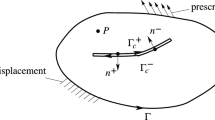Abstract
A boundary element technique, based on a pure displacement discontinuity formulation, is presented to solve general problems of interaction between cracks. The procedure allows detailed information and high precision at the expense of a reasonable computational effort. The comparisons with exact solutions and numerical ones for elementary case show a good performance of the method in the case of strong interacting cracks too. The interaction of a main crack with some microcrack arrays is studied in terms of amplification and shielding of the SIF at the main crack tip.
The analysis of the results shows that, while shielding can be considered a short range phenomenon, amplification has a wider range involving more distant microcracks; this fact fits well with some experimental investigations given in the literature.
Similar content being viewed by others
References
L.X. Han and S. Suresh, High-temperature failure of an Alumina-Silicon Carbide composite under cyclic loads: mechanisms of fatigue crack tip damage, Journal of the American Ceramic Society 72 (1989) 1233–1238.
J.W. Hutchinson, Crack tip shielding by micro-cracking in brittle solids, Acta Metallurgica 35 (1987) 1609–1619.
M. Ruhle, A.G. Evans, R.M. McMeeking, P.G. Charalambides and J.W. Hutchinson, Microcrack toughening in Alumina/Zirconia, Acta Metallurgica 35 (1987) 2701–2710.
W. Kreher and W. Pompe, Increased fracture toughness of ceramics by energy-dissipative mechanisms, Journal of Material Science 16 (1981) 694–706.
D.R. Clarke, A simple calculation of process-zone toughening by microcracking, Commentaries of the American Ceramic Society, January 1984, C-15, C-16.
L.R. Rose, Microcrack interaction with a main crack, International Journal of Fracture 31 (1986) 233–242.
A.A. Rubinstein, Macrocrack interaction with semi-infinite microcrack array, International Journal of Fracture 27 (1985) 113–119.
A.A. Rubinstein and H.C. Choi, Macrocrack interaction with transverse array of microcracks, International Journal of Fracture 36 (1988) 15–26.
H. Horii and S. Nemat-Nasser, Elastic fields of interacting inhomogeneities, International Journal of Solids and Structures 21 (1985) 731–745.
S. Gong and H. Horii, General solution to the problem of microcracks near the tip of a main crack, Journal of Mechanics and Physics of Solids 37 (1989) 27–46.
K.Y. Lam, C. Wen and Z. Phua, Interaction between microcracks and a main crack in a semi-infinite medium, Engineering Fracture Mechanics 44 (1993) 753–761.
M. Kachanov, Elastic solids with many cracks: a simple method of analysis, International Journal of Solids and Structures 23 (1987) 23–43.
M. Kachanov and E. Montagut, Interaction of a crack with certain microcrack arrays, Engineering Fracture Mechanics 25 (1986) 625–636.
P.G. Charambides and R.M. McMeeking, Finite element method simulation of a crack propagation in a brittle microcracked solid, Mechanics of Materials 6 (1987) 71–87.
X. Huang and B.L. Karihaloo, Interaction of penny shaped cracks with a half plane crack, International Journal of Solids and Structures 25 (1993) 591–607.
S.L. Crouch, Solution of plane elasticity problems by the displacement discontinuity method: I Infinite body solution; II Semi-infinite body solution, International Journal for Numerical Methods in Engineering 10 (1976) 301–343.
S.L. Crouch and A.M. Starfield, Boundary Element Methods in Solid Mechanics, Unwin Hyman, Cambridge (1983).
A. Carpinteri, Mechanical Damage and Crack Growth in Concrete, Martinus Nijhoff Publishers, Dordrecht (1986).
A. Dolgopolsky, V. Karbhari and S.S. Kwak, Microcrack induced toughening — an interaction model, Acta Metallurgica 37 (1989) 1349–1354.
C. Scavia, A numerical technique for the analysis of cracks subjected to normal compressive stresses, International Journal for Numerical Methods in Engineering 33 (1992) 929–942.
J.P. Laures and M. Kachanov, Three dimensional interactions of a crack front with arrays of penny-shaped microcracks, International Journal of Fracture 48 (1991) 255–279.
A. Brencich, A. Carpinteri and C. Scavia, Disorder effects on the interaction between a main crack and a distribution of microcracks, Journal of Applied Mechanics (ASME), submitted for publication.
Author information
Authors and Affiliations
Rights and permissions
About this article
Cite this article
Brencich, A., Carpinteri, A. Interaction of a main crack with ordered distributions of microcracks: a numerical technique by displacement discontinuity boundary elements. Int J Fract 76, 373–389 (1996). https://doi.org/10.1007/BF00039784
Received:
Accepted:
Published:
Issue Date:
DOI: https://doi.org/10.1007/BF00039784




